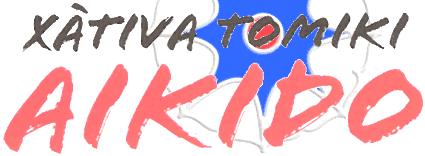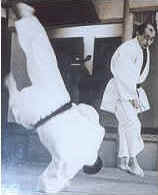|
BASIC FOOT MOVEMENTS (MOVIMIENTOS BÁSICOS DEL PIE)
INTRODUCTION
Although we practise the Foot & Hand Movements formally in a class
situation in lines, these exercises could, and in fact should, be
practised individually, at home, by oneself. Primarily they teach us to
move in a "Shuffle" or succeeding feet manner (Tsugi-ashi), in
keeping with good posture, balance and co-ordination. Furthermore, they
help us to maintain a right or left defensive, yet natural posture, whilst
moving. Normal walking (Ayumi-ashi) is a succession of right & left
defensive postures and the retention of balance can be difficult,
particularly if large steps are taken. Simply they are about natural and
efficient movement. They are basic building blocks and once mastered they
can be applied to any discipline.
INTRODUCCIÓN
A pesar de que la práctica del pie y movimientos de la mano formalmente en una situación de clase en las líneas, estos ejercicios pueden, y de hecho deben, ser practicado de forma individual, en casa, por uno mismo. Principalmente nos enseñan a moverse en un "Shuffle" o el éxito de manera pies (tsugi-ashi), de acuerdo con una buena postura equilibrio y coordinación. Además, nos ayudan a mantener un derecho o izquierdo defensivo, sin embargo, la postura natural, si bien se mueve. caminar normal (Ayumi-Ashi) es una sucesión de derecha e izquierda posturas defensivas y el mantenimiento del equilibrio puede ser difícil, especialmente si se toman medidas grandes. Simplemente están sobre el movimiento natural y eficiente. Ellos son los bloques básicos de construcción y una vez dominado, se pueden aplicar a cualquier disciplina.
As an example, if we take tennis, here we have backhand strokes, these
relate to our inside sweep and outside turn action. The forehand strokes
in movement are similar to our outside sweep and inside turn. To be able
to control the ball, first the player must develop full control of his or
her own body. In short the basic foot & hand movements of Tomiki
Aikido form the basis of many other disciplines and that the study of
Tomiki Aikido is a good way of learning any Martial Art and a large number
of what would initially appear to be non-related sports.
Por ejemplo, si tomamos tenis, aquí tenemos a golpes de revés, estos se relacionan con nuestro barrido dentro y fuera de acción a su vez. Los golpes de derecha en el movimiento son similares a nuestro barrido exterior y a su vez en el interior. Para poder controlar el balón, en primer lugar el jugador debe desarrollar el pleno control de su propio cuerpo. En resumen, el pie de base y movimientos de la mano de Tomiki Aikido forma la base de muchas otras disciplinas y que el estudio de Tomiki Aikido es una buena manera de aprender cualquier arte marcial y un gran número de lo que inicialmente parece ser deportes no relacionados.
FOOT MOVEMENTS (Onsoku)
This is the basis of our system of Aikido and also Judo. It reinforces the
eight directions of movement. It relates to eight directions of balance
breaking (Kuzushi) or the eight throwing directions. When practised
whether alone or in a group, the individual is setting neuro-muscular
response patterns which are developing stability, central alignment,
control and balance through regulating the centre of gravity. At this
stage it has little to do with avoidance and timing, in the Martial Arts
sense. By definition it excludes any movement of the hands and arms. There
are eight directions of movement in the Foot movements.
PIE DE MOVIMIENTOS (Onsoku)
Esta es la base de nuestro sistema de Aikido y Judo. Refuerza las ocho direcciones de movimiento. Se refiere a ocho direcciones de romper el equilibrio (Kuzushi) o las ocho direcciones de lanzamiento. Cuando se practica ya sea solos o en grupo, el individuo está fijando patrones de respuesta neuromuscular que están desarrollando la estabilidad, la alineación central, control y equilibrio a través de la regulación del centro de gravedad. En esta etapa, tiene poco que ver con la evitación y el calendario, en el sentido de las Artes Marciales. Por definición, excluye cualquier movimiento de las manos y los brazos. Hay ocho direcciones de movimiento en los movimientos del pie. |
1. Recta hacia delante
2. Recta hacia atrás
3. De lado a la izquierda
4. De lado a la derecha
5. Esquina frontal izquierda
6. Frente esquina derecha
7. Esquina trasera izquierda
8. Esquina trasera derecha |
| El círculo central representa el individuo y los ocho puntos de la estrella son las
instrucciones. |
Their representation can be clearly seen in
the Tomiki Mon and the British Flag.
Su representación puede verse claramente en los Mon Tomiki y la bandera británica.
As an exercise these are practised in sets of three. Starting with the
left foot, each set is performed to the count of eight. Start and finish
in Basic Front Posture. The movements should be quick, light and
relatively small, ensuring that both feet are fully contacting the mat
during pauses. During the movements the feet must maintain a
shoulder-width-apart distance and be kept close to the mat; use a gliding
or sweeping action. When performing these exercises, practise by counting
then swiftly moving.
Como un ejercicio de estos se practican en grupos de tres. Comenzando con el pie izquierdo, cada sistema se realiza a la cuenta de ocho. Salida y llegada en la postura básica frente. Los movimientos deben ser rápidos, ligeros y relativamente pequeño, asegurándose de que ambos pies están completamente en contacto con la colchoneta durante las pausas. Durante los movimientos de los pies deben mantener un hombro-anchura-aparte de la distancia y estar cerca de la estera, el uso de una acción de deslizamiento o barrer. Al realizar estos ejercicios, prácticas, contando entonces con rapidez en movimiento.
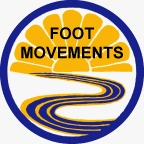 |
Yamada
Sensei performs Unsoku in 1959
(Yamada Sensei realiza Unsoku en 1959)
(pictures courtesy of Kikusui
Kai)
(Fotos cortesía de Kikusui Kai)
|
BASIC FRONT POSTURE (Nami-Shizentai)
Stand upright, knees soft, with the feet in-line & shoulder width
apart, hands resting lightly on hips with fingers extended, pointing
slightly downwards.
POSTURA FRENTE AL BÁSICO (Nami-Shizentai)
Póngase de pie, las rodillas suaves, con los pies en línea y anchura de los hombros, las manos apoyadas ligeramente en las caderas con los dedos extendidos, apuntando ligeramente hacia
abajo.
1) STRAIGHT, FORWARDS & BACKWARDS
(AVANZANDA EN LINEA RECTA, y HACIA
ATRÁS)
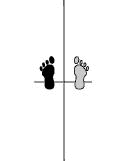
COUNTING "ONE": Step forwards
with the left foot, immediately bring forward the right foot behind it.
COUNTING "TWO": Step backwards with the right foot, immediately
bring backwards the left foot. Maintain the relative feet positioning
(left in front of right).
COUNTING "THREE": Take a further step backwards with the right
foot, immediately bring backwards the left foot. Maintain the relative
feet positioning (left in front of right).
COUNTING "FOUR": Return to basic front posture by stepping
forward with the left foot then immediately bringing forward the right
foot.
COUNTING "FIVE, SIX, SEVEN & EIGHT": Repeat the sequence
starting with the right foot.
CONTANDO "UNO": Paso hacia delante con el pie izquierdo, inmediatamente adelantar el pie derecho detrás de ella.
CONTANDO "DOS": Paso atrás con el pie derecho, poner inmediatamente el pie izquierdo hacia atrás. Mantener la posición de los pies con respecto (a la izquierda frente a derecha).
CONTANDO "TRES": dar un paso más hacia atrás con el pie derecho, poner inmediatamente el pie izquierdo hacia atrás. Mantener la posición de los pies con respecto (a la izquierda frente a derecha).
CONTANDO "CUATRO": Volver a la postura delantera básica dando un paso adelante con el pie izquierdo e inmediatamente adelantar el pie derecho.
CONTANDO "CINCO, SEIS, SIETE y OCHO": Repetir la secuencia de arranque con el pie
derecho.
2) SIDEWAYS, TO THE LEFT AND RIGHT
(HACIA
LOS LADOS, A LA IZQUIERDA Y DERECHA)
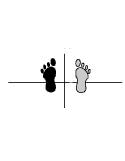
COUNTING "ONE": Step to the left
side with the left foot, immediately move the right foot towards the left
foot, maintaining the correct distance between the feet.
COUNTING "TWO": Return to basic front posture by stepping
sideways with the right foot then immediately bringing the left foot
towards it.
COUNTING "THREE": Step to the right side with the right foot,
immediately move the left foot towards the right foot, maintaining the
correct distance between the feet.
COUNTING "FOUR": Return to basic front posture by stepping
sideways with the left foot then immediately bringing the right foot
towards it.
COUNTING "FIVE", "SIX", "SEVEN" &
"EIGHT": Repeat the sequence starting with the right foot to the
right side.
CONTANDO "UNO": el paso hacia el lado izquierdo con el pie izquierdo, la debe trasladar inmediatamente el pie derecho hacia el pie izquierdo, manteniendo la distancia correcta entre los pies.
CONTANDO "DOS": Volver a la postura delantera básica mediante el refuerzo de costado con el pie derecho e inmediatamente con lo que el pie izquierdo hacia ella.
CONTANDO "TRES": Paso a la derecha con el pie derecho, debe trasladar inmediatamente el pie izquierdo hacia el pie derecho, manteniendo la distancia correcta entre los pies.
CONTANDO "CUATRO": Volver a la postura delantera básica mediante el refuerzo de costado con el pie izquierdo e inmediatamente con lo que el pie derecho hacia ella.
CONTANDO "CINCO", "SEIS", "SIETE" y "OCHO": Repetir la secuencia de arranque con el pie derecho hacia el lado
derecho.
3) CORNERS, FRONT & REAR, LEFT & RIGHT
(ESQUINAS, DELANTE y DETRÁS, IZQUIERDA y DERECHA)
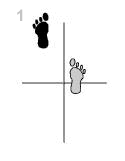
COUNTING "ONE": Step forward and
turn the body through 90 degrees to the left, immediately move the right
foot towards the left foot, maintaining the correct distance between the
feet.
COUNTING "TWO": Return to the starting position, basic front
posture, by stepping with the right foot then immediately bringing the
left foot towards it.
COUNTING "THREE" & "FOUR": Repeat the sequence
starting with the right foot and turning the body through 90 degrees to
the right, before returning to basic front posture.
COUNTING "FIVE": Sweep the right foot in an arc to the left
rear, turning the body through 90 degrees to the left. Immediately move
the left foot towards the right foot, maintaining the correct distance
between the feet.
COUNTING "SIX": Return to the starting position, basic front
posture, by stepping with the left foot then immediately bringing the
right next to it, still maintaining the correct distance between the feet.
COUNTING "SEVEN" & "EIGHT": Repeat the sequence
starting with the left foot and turning the body through 90 degrees to the
right rear, before returning to basic front posture.
CONTANDO "UNO": un paso adelante y girar el cuerpo a través de 90 grados a la izquierda, inmediatamente mueva el pie derecho hacia el pie izquierdo, manteniendo la distancia correcta entre los pies.
CONTANDO "DOS": Volver a la posición inicial, la postura delantera básica, dando un paso con el pie derecho luego de inmediato con lo que el pie izquierdo hacia ella.
CONTANDO "TRES" y "CUATRO": Repetir la secuencia de arranque con el pie derecho y girando el cuerpo a través de 90 grados a la derecha, antes de regresar a la postura delantera básica.
CONTANDO "CINCO": barrer el pie derecho en un arco en la parte trasera izquierda, girando el cuerpo a través de 90 grados a la izquierda. Inmediatamente mover el pie izquierdo hacia el pie derecho, manteniendo la distancia correcta entre los pies.
CONTANDO "SEIS": Volver a la posición inicial, la postura delantera básica, dando un paso con el pie izquierdo e inmediatamente con lo que el derecho a su lado, manteniendo la distancia correcta entre los pies.
CONTANDO "SIETE" y "OCHO": Repetir la secuencia de arranque con el pie izquierdo y girando el cuerpo a través de 90 grados hacia la parte posterior derecha, antes de regresar a la postura delantera básica.
|


